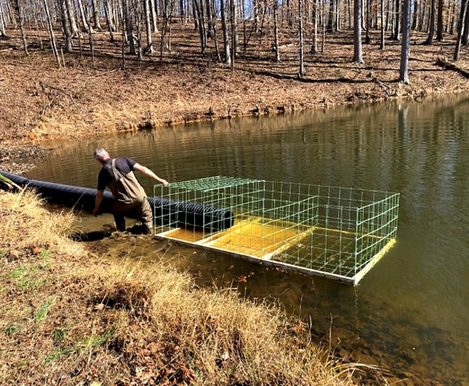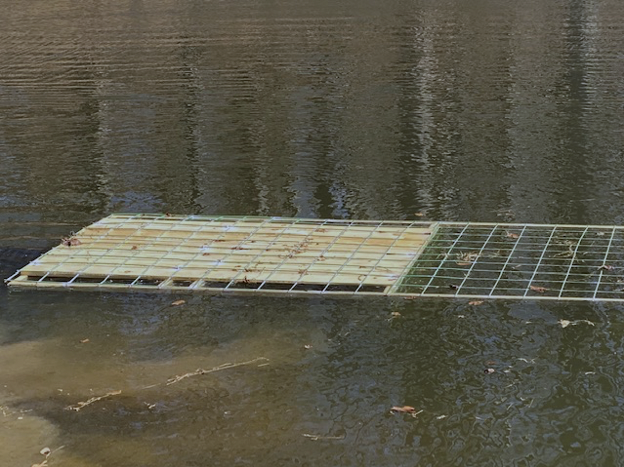 Sixty feet of twelve-inch double walled polyethylene pipe, coated mesh and special filters are part of the device that will allow water to flow through the spillway that the local beavers were once constantly blocking. Photo by Donna Cottingham.
Sixty feet of twelve-inch double walled polyethylene pipe, coated mesh and special filters are part of the device that will allow water to flow through the spillway that the local beavers were once constantly blocking. Photo by Donna Cottingham. --Contributed by Donna Cottingham, VMN-James River Chapter.
While many people find it difficult to coexist with beavers on their property, others are interested in ways to live peacefully with the engineering mammals. Skip Lisle was in Virginia recently to lend an expert hand to several landowners in the area who decided killing beavers was not their best option for coping with them.
Lisle, with a Master’s Degree in Wildlife Conservation, has spent most of his life working on beaver conservation by helping landowners, National Parks and various government agencies overcome issues with beavers. His interest in beavers first began when he was a teen living in Vermont, where he created several devices to help his parents prevent a road from flooding on the family property after beavers dammed a culvert.
“Beavers are very adaptable creatures and many people don’t realize how beneficial they are,” said Lisle. He explained that beaver dams can create fertile wetlands that can support quality wildlife habitats for other animals. In Nevada, beavers turned an area of the desert into a wetlands oasis that now supports mule deer, Sandhill cranes, and other wildlife. In fact, many states are re-introducing beavers back into the wild.
Beavers build dams to protect their lodges, and the vegetation that grows in the newly flooded area becomes food and building materials for them. Wetlands created by beaver dams can increase biodiversity, replenish drinking water aquifers, trap and store carbon, and store ground water in dry areas. One small town in Alaska even gets its drinking water from a large reservoir created by a beaver dam.
Scientific studies prove beaver ponds are also beneficial to fish. Not only do the ponds support insects and invertebrates for fish food, they also provide a safe nursery to protect young fish from predators. Additionally, beaver ponds also provide refuge, food and cover for a wide variety of ducks.
Although they were once a thriving species in the hundreds of millions in North America, beavers nearly went extinct as settlers trapped and killed them. On the Lewis and Clark Expedition, Meriwether Lewis wrote in his journals about waters everywhere teeming with beavers. In fact, he even wrote that the men enjoyed hearty meals of cooked beaver tails.
Realizing the benefits that eco-engineering beavers bring to the environment, Lisle has spent years advocating for beavers and perfecting the device that he first created as a teenager. Today he calls his device the “beaver deceiver,” and travels the U.S. helping to settle human – beaver conflicts by installing his flow device.
Editor's Note: Katie Martin, biologist with the Virginia Department of Wildlife Resources, reviewed this article and noted that DWR uses a similar device on many of its Wildlife Management Areas where there are issues with beavers flooding the roadways, as they too want to keep the beavers there for all their amazing wetland benefits!
While many people find it difficult to coexist with beavers on their property, others are interested in ways to live peacefully with the engineering mammals. Skip Lisle was in Virginia recently to lend an expert hand to several landowners in the area who decided killing beavers was not their best option for coping with them.
Lisle, with a Master’s Degree in Wildlife Conservation, has spent most of his life working on beaver conservation by helping landowners, National Parks and various government agencies overcome issues with beavers. His interest in beavers first began when he was a teen living in Vermont, where he created several devices to help his parents prevent a road from flooding on the family property after beavers dammed a culvert.
“Beavers are very adaptable creatures and many people don’t realize how beneficial they are,” said Lisle. He explained that beaver dams can create fertile wetlands that can support quality wildlife habitats for other animals. In Nevada, beavers turned an area of the desert into a wetlands oasis that now supports mule deer, Sandhill cranes, and other wildlife. In fact, many states are re-introducing beavers back into the wild.
Beavers build dams to protect their lodges, and the vegetation that grows in the newly flooded area becomes food and building materials for them. Wetlands created by beaver dams can increase biodiversity, replenish drinking water aquifers, trap and store carbon, and store ground water in dry areas. One small town in Alaska even gets its drinking water from a large reservoir created by a beaver dam.
Scientific studies prove beaver ponds are also beneficial to fish. Not only do the ponds support insects and invertebrates for fish food, they also provide a safe nursery to protect young fish from predators. Additionally, beaver ponds also provide refuge, food and cover for a wide variety of ducks.
Although they were once a thriving species in the hundreds of millions in North America, beavers nearly went extinct as settlers trapped and killed them. On the Lewis and Clark Expedition, Meriwether Lewis wrote in his journals about waters everywhere teeming with beavers. In fact, he even wrote that the men enjoyed hearty meals of cooked beaver tails.
Realizing the benefits that eco-engineering beavers bring to the environment, Lisle has spent years advocating for beavers and perfecting the device that he first created as a teenager. Today he calls his device the “beaver deceiver,” and travels the U.S. helping to settle human – beaver conflicts by installing his flow device.
Editor's Note: Katie Martin, biologist with the Virginia Department of Wildlife Resources, reviewed this article and noted that DWR uses a similar device on many of its Wildlife Management Areas where there are issues with beavers flooding the roadways, as they too want to keep the beavers there for all their amazing wetland benefits!



 RSS Feed
RSS Feed